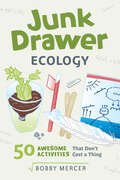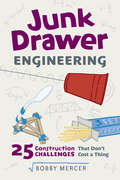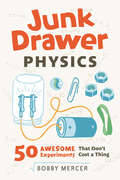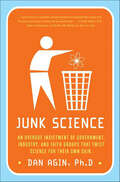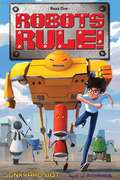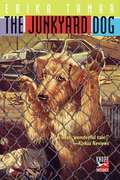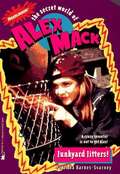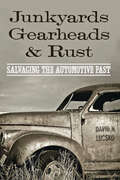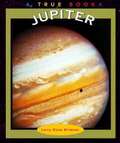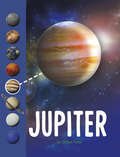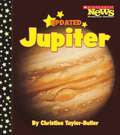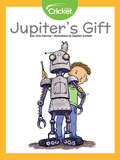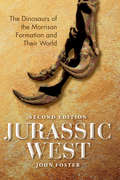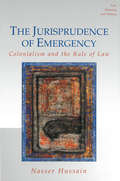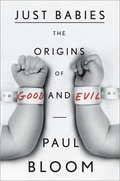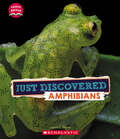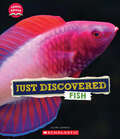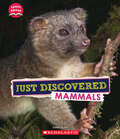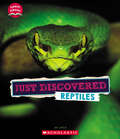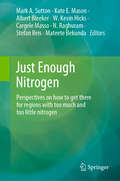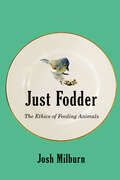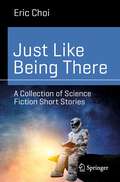- Table View
- List View
Junk Drawer Ecology: 50 Awesome Experiments That Don't Cost a Thing (Junk Drawer Science #7)
by Bobby MercerKids of all ages can use recycled and repurposed household items to complete exciting and green ecology experimentsJunk Drawer Ecology is a hands-on guide to saving the planet. Fun, free science activities help kids of all ages learn about the science of our planet's ecology. The environment is changing every day, and we can help slow that change. Using free or low-cost things children already have around their homes, these activities are perfect to stimulate young brains. Readers will learn about the importance of the polar regions without leaving their communities, about new ways to cut our dependence on fossil fuels, about all forms of pollution, and how they can make a difference.Junk Drawer Ecology will give inquisitive kids many hours of fun and help them learn at the same time.
Junk Drawer Engineering: 25 Construction Challenges That Don't Cost a Thing
by Bobby MercerThere's no need for expensive, high-tech materials to test your engineering skills—you probably have all you need in your home junk drawer. Each hands-on project in this book will challenge you to come up with a unique solution to a specific design problem. Construct a Pasta Bridge strong enough to support a heavy load, using only dry linguini and glue. Build a Marble Roller Coaster from recycled cardboard tubes, in which the marble "car" jumps a track to land safely at its final destination. Or design an Egg Catch device to safely capture a free-falling egg. Test yourself or use them for friendly competitions—who can come up with the best solution? These 25 open-ended design challenges can be performed for just pennies . . . or less. Each project has a suggested materials list, step-by-step instructions with illustrations for one possible solution, and suggestions on how to adapt each challenge for different ages and skill levels. Educators and parents will find this title a handy resource to teach children problem-solving skills and applied physics, all while having a lot of fun.
Junk Drawer Physics: 50 Awesome Experiments That Don't Cost a Thing
by Bobby MercerA children's instructional book on how to use readily available materials to turn the house into a science lab Physics teacher Bobby Mercer provides readers with more than 50 great hands-on experiments that can be performed for just pennies, or less. Turn a plastic cup into a pinhole camera using waxed paper, a rubber band, and a thumbtack. Build a swinging wave machine using a series of washers suspended on strings from a yardstick. Or construct your own planetarium from an empty potato chip canister, construction paper, scissors, and a pin. Each project has a materials list, detailed step-by-step instructions with illustrations, and a brief explanation of the scientific principle being demonstrated. Junk Drawer Physics also includes sidebars of fascinating physics facts, such as did you know the Eiffel Tower is six inches taller in summer than in winter because its steel structure expands in the heat? Educators and parents will find this title a handy resource to teach children about physics topics that include magnetism, electricity, force, motion, light, energy, sound, and more, and have fun at the same time.
Junk Science: An Overdue Indictment of Government, Industry, and Faith Groups that Twist Science for Their Own Gain
by Dan AginAn overdue indictment of government, industry, and faith groups that twist science for their own gain.During the next thirty years, the American public will suffer from a rampage against reason by special interests in government, commerce, and the faith industry, and the rampage has already begun. In Junk Science, Dan Agin offers a response—a stinging condemnation of the egregious and constant warping of science for ideological gain.In this provocative, wide-ranging, and hard-hitting book, Agin argues from the center that we will pay a heavy price for the follies of people who consciously twist the public's understanding of the real world.In an entertaining but frank tone, Agin separates fact from conveniently "scientific" fiction and exposes the data faking, reality ignoring, fear mongering, and outright lying that contribute to intentionally manufactured public ignorance. Many factions twist scientific data to maintain riches and power, and Agin outs them all in sections like these:--"Buyer Beware" (genetically modified foods, aging, and tobacco companies)--"Medical Follies" (chiropractics, health care, talk therapy)--"Poison and Bombs in the Greenhouse" (pollution, warfare, global warming)--"Religion, Embryos, and Cloning"--"Genes, Behavior, and Race"We already pay a heavy price for many groups' conscious manipulation of the public's understanding of science, and Junk Science arms us with understanding, cutting through the fabric of lies and setting the record straight.
The Junkyard Bot
by Goro Fujita C. J. RichardsWorker robots keep the high-tech town of Terabyte Heights humming, but ten-year-old George Gearing is the only one who has a robot for a best friend. When his scrappy but beloved pal Jackbot is hit by a car, the whiz kid re-engineers him with fancy parts from state-of-the-art TinkerTech Laboratories. Jackbot's astounding new skills far exceed anything George--or even TinkerTech's head of robotics--could ever have imagined. Will the villainous Dr. Micron destroy the whole town to see his tech-driven dream realized? Not if George can help it . . .
Junkyard Jitters! (The Secret World of Alex Mack #11)
by Patricia Barnes-SvarneyWhen Ray asks Alex to help him with his paper route, she can hardly turn him down. What are best friends for, anyway? But tossing the news is hard work, and Alex can't resist using her powers to help out. Not that there's anyone around to see...except the eccentric old inventor who lives in the junkyard. When he catches Alex flowing like a lightning bug, she's only a little worried. But then the goons from Paradise Valley Chemical show up at the junkyard, too. Did the old man blow the whistle on her? Or is he working for the plant...on an invention to catch the GC-161 kid?
Junkyards, Gearheads, and Rust: Salvaging the Automotive Past
by David N. LucskoThe material appeal of the automobile junkyard goes beyond the search for second-hand parts.What happens to automobiles after they are retired but before they are processed as scrap? In this fascinating history, David N. Lucsko takes readers on a tour of salvage yards and wrecked or otherwise out-of-service cars in the United States from the point of view of gearheads—the hot rodders, restoration hobbyists, street rodders, and classic car devotees who reuse, repurpose, and restore junked cars.Junkyards, Gearheads, and Rust is a nuanced exploration of the business of dismantling wrecks and selling second-hand parts. It examines the reinterpretation of these cars and parts by artists as well as their restoration by enthusiasts. It also surveys the origin and evolution of gearhead-oriented yards that specialize in specific types of automobiles; dissects the material and emotional appeal of the salvage yard and its contents among enthusiasts; and examines how zoning and nuisance ordinances have affected both salvage businesses and hobbyists. Lucsko concludes with an analysis of efforts during the last twenty-five years to hasten vehicular obsolescence at the expense of salvage yards, mechanics, and enthusiasts. By examining how cars are salvaged, repurposed, and restored, this book demonstrates that the history of the automobile is much more than a running catalog of showroom novelties.
Jupiter: A True Book
by Larry Dane BrimnerDescribes the appearance, climate, moons, and exploration of the largest planet in the solar system.
Jupiter (Planets in Our Solar System)
by Steve FoxeEverything about Jupiter is big! Its size is big. Even its storms are big! Get the big and small facts about this gas giant that can be seen glowing in the night sky.
Jupiter
by Christine Taylor-ButlerFeatures: - Includes vocabulary word hunt with pronunciations, glossary, and index - Labeled diagrams and timelines - Beautiful, full-color photographs - Simple interior design and easy-to-read fonts - Web sites for further research and information - Vocabulary preview and review pages plus backmatter pages that invite readers to think further on the study topics - Fits science curriculum standards for earth & space science and science and technology What's New: - Updated illustrations and photos - Updated art of solar system shows 8 planets and their orbits instead of 9 - New Pluto book includes a list of other dwarf planets, in addition to Pluto, in our solar system - Updated information on space missions, moons, and planets - Updated Web sites for further information in backmatter - Updated indexes
Jupiter, Ceres and the Asteroids (World Book's Solar System and Space Exploration Library)
by Dan Blunk"Introduction to Jupiter, Ceres, and the Asteroids, providing to primary and intermediate grade students information on their features and exploration. Includes fun facts, glossary, resource list and index"--Provided by publisher.
Jupiter (Planet Guides)
by Duncan BrewerThis short but informative book gives many fascinating facts about the Planet Jupiter. The book outlines the planet's history and scientific discovers about it through the ages. It talks about the planets place in mythology, as well as what NASA has discovered about its composition. Contains a glossary of terms, recommended books to read, and some very fascinating facts about its many moons. Worth reading for anyone interested in the planet Jupiter.
Jupiter's Gift
by John SamonyTim is working on his science fair project—a robot! When he spends a weekend afternoon with his great-uncle, he learns that his love of engineering and technology runs in the family. After Great-Uncle Bate lends him a little creativity to help figure out what’s wrong with the robot, Tim learns an awesome secret about him!
Jurassic West, Second Edition: The Dinosaurs of the Morrison Formation and Their World (Life of the Past)
by John FosterThe famous bone beds of the Morrison Formation, formed one hundred and fifty million years ago and running from Wyoming down through the red rock region of the American Southwest, have yielded one of the most complete pictures of any ancient vertebrate ecosystem in the world. Jurassic West, Second Edition tells the story of the life of this ancient world as scientists have so far been able to reconstruct it.Aimed at the general reader, Jurassic West, Second Edition recounts the discovery of many important Late Jurassic dinosaurs such as Apatosaurus, Allosaurus, and Stegosaurus. But dinosaurs compose barely a third of the more than 90 types of vertebrates known from the formation, which include crocodiles and turtles, frogs and salamanders, dinosaurs and mammals, clams and snails, and ginkgoes, ferns, and conifers.Featuring nearly all new illustrations, the second edition of this classic work includes new taxa named since 2007, updates to the naming and classifications of some old taxa, and expanded sections on numerous aspects of Morrison Formation paleontology and geology.
The Jurisprudence of Emergency
by Nasser HussainHussain analyses the uses and the history of a range of emergency powers, such as the suspension of habeas corpus and the use of military tribunals. His study focuses on British colonialism in India from the late eighteenth to the early twentieth century to demonstrate how questions of law and emergency shaped colonial rule, which in turn affected the place of colonialism in modern law, depicting the colonies not as passive recipients but as agents in the interpretation and delineation of Western ideas and practices. Nasser Hussain is Professor of History at Amherst College.
Just Babies: The Origins of Good and Evil
by Paul Bloom<P>A leading cognitive scientist argues that a deep sense of good and evil is bred in the bone. From John Locke to Sigmund Freud, philosophers and psychologists have long believed that we begin life as blank moral slates. Many of us take for granted that babies are born selfish and that it is the role of society--and especially parents--to transform them from little sociopaths into civilized beings. <P>In Just Babies, Paul Bloom argues that humans are in fact hardwired with a sense of morality. Drawing on groundbreaking research at Yale, Bloom demonstrates that, even before they can speak or walk, babies judge the goodness and badness of others' actions; feel empathy and compassion; act to soothe those in distress; and have a rudimentary sense of justice. <P>Still, this innate morality is limited, sometimes tragically. We are naturally hostile to strangers, prone to parochialism and bigotry. Bringing together insights from psychology, behavioral economics, evolutionary biology, and philosophy, Bloom explores how we have come to surpass these limitations. <P> Along the way, he examines the morality of chimpanzees, violent psychopaths, religious extremists, and Ivy League professors, and explores our often puzzling moral feelings about sex, politics, religion, and race. In his analysis of the morality of children and adults, Bloom rejects the fashionable view that our moral decisions are driven mainly by gut feelings and unconscious biases. <P>Just as reason has driven our great scientific discoveries, he argues, it is reason and deliberation that makes possible our moral discoveries, such as the wrongness of slavery. Ultimately, it is through our imagination, our compassion, and our uniquely human capacity for rational thought that we can transcend the primitive sense of morality we were born with, becoming more than just babies. <P>Paul Bloom has a gift for bringing abstract ideas to life, moving seamlessly from Darwin, Herodotus, and Adam Smith to The Princess Bride, Hannibal Lecter, and Louis C.K. Vivid, witty, and intellectually probing, Just Babies offers a radical new perspective on our moral lives. <P><b>A New York Times Bestseller</b>
Just Discovered Amphibians (Learn About)
by Danielle DenegaLet's learn all about newly discovered animals!Have you ever seen a glass frog or a pumpkin toadlet? Now you can! With amazing photos and lively text, this book explores five new species of amphibians. Get ready to learn all about how, when, and where these animals were discovered!ABOUT THE SERIES:Did you know scientists discover thousands of new species every year? Some are even named after things in popular culture like the Wakanda fish (Black Panther) and the Salazar's pit viper (Harry Potter). This vibrant new set of Learn About books gives readers a close-up look into five of the most fascinating new species of amphibians, fish, mammals, and reptiles that have been found on Earth in the past few years. Each book explores how, where, and when they were found, along with their habitat, diet, and survival skills. Packed with photographs and fun facts, readers will learn all about these exciting new species in the natural world.
Just Discovered Fish (Learn About)
by Claire CaprioliLet's learn all about newly discovered animals!Have you ever seen a Wakanda fish or a blue snailfish? Now you can! With amazing photos and lively text, this book explores five new species of fish. Get ready to learn all about how, when, and where these animals were discovered!ABOUT THE SERIES:Did you know scientists discover thousands of new species every year? Some are even named after things in popular culture like the Wakanda fish (Black Panther) and the Salazar's pit viper (Harry Potter). This vibrant new set of Learn About books gives readers a close-up look into five of the most fascinating new species of amphibians, fish, mammals, and reptiles that have been found on Earth in the past few years. Each book explores how, where, and when they were found, along with their habitat, diet, and survival skills. Packed with photographs and fun facts, readers will learn all about these exciting new species in the natural world.
Just Discovered Mammals (Learn About)
by Sonia W. BlackLet's learn all about newly discovered animals!Have you ever seen a spotted skunk or an orange bat? Now you can! With amazing photos and lively text, this book explores five new species of mammals. Get ready to learn all about how, when, and where these animals were discovered!ABOUT THE SERIES:Did you know scientists discover thousands of new species every year? Some are even named after things in popular culture like the Wakanda fish (Black Panther) and the Salazar's pit viper (Harry Potter). This vibrant new set of Learn About books gives readers a close-up look into five of the most fascinating new species of amphibians, fish, mammals, and reptiles that have been found on Earth in the past few years. Each book explores how, where, and when they were found, along with their habitat, diet, and survival skills. Packed with photographs and fun facts, readers will learn all about these exciting new species in the natural world.
Just Discovered Reptiles (Learn About)
by Jay LeslieLet's learn all about newly discovered animals!Have you ever seen a Salazar's pit viper or a nano chameleon? Now you can! With amazing photos and lively text, this book explores five new species of reptiles. Get ready to learn all about how, when, and where these animals were discovered!ABOUT THE SERIES:Did you know scientists discover thousands of new species every year? Some are even named after things in popular culture like the Wakanda fish (Black Panther) and the Salazar's pit viper (Harry Potter). This vibrant new set of Learn About books gives readers a close-up look into five of the most fascinating new species of amphibians, fish, mammals, and reptiles that have been found on Earth in the past few years. Each book explores how, where, and when they were found, along with their habitat, diet, and survival skills. Packed with photographs and fun facts, readers will learn all about these exciting new species in the natural world.
Just Enough Nitrogen: Perspectives on how to get there for regions with too much and too little nitrogen
by Mark A. Sutton Kate E. Mason Albert Bleeker W. Kevin Hicks Cargele Masso N. Raghuram Stefan Reis Mateete BekundaThis volume provides a unique collection of contributions addressing both the ‘too much’ and ‘too little’ sides of the nitrogen story. Building on analyses started at the 6th International Nitrogen Conference, Kampala, the book explores the idea of ‘just enough nitrogen’: sufficient for sustainable food production, but not so much as to lead to unsustainable pollution and climate problems. The range of nitrogen threats examined, solutions evaluated and science-policy analyses presented here has provided the foundation to agree the ‘Kampala Statement-for-Action on Nitrogen in Africa and Globally,’ as reported in this volume. Humanity today faces unprecedented challenges: How to feed a growing population? How to reduce air pollution, water pollution and climate change? How to handle regional differences in an era of increasing globalization? These questions are at the heart of this edited volume which examines the multi-dimensional nature of the global nitrogen challenge. While humans have massively altered the nitrogen cycle, the consequences have become polarized. Some regions have too much nitrogen, associated with pollution and wasteful use of a valuable resource, while other regions have too little nitrogen, leading to constraints on food production and depletion of soil nutrient stocks. The volume provides a unique collection of contributions addressing both the ‘too much’ and ‘too little’ sides of the nitrogen story. Building on analyses started at the 6th International Nitrogen Conference, Kampala, the book explores the idea of ‘just enough nitrogen’: sufficient for sustainable food production, but not so much as to lead to unsustainable pollution and climate problems. The range of nitrogen threats examined, solutions evaluated and science-policy analyses presented here has provided the foundation to agree the ‘Kampala Statement-for-Action on Nitrogen in Africa and Globally,’ as reported in this volume. Together, the contributions in this book are now informing actions by the International Nitrogen Initiative (INI) in working with the United Nations Environment Programme and others to establish the International Nitrogen Management System (INMS). A key outcome has been to catalyse development of the first Resolution on Sustainable Nitrogen Management, as adopted by the fourth UN Environment Assembly (UNEA/EA.4/Res.14).The work is written for researchers and policy makers and all those interested in seeing how sustainable nitrogen management can contribute to meeting many of the UN Sustainable Development Goals.
Just Fodder: The Ethics of Feeding Animals
by Josh MilburnAnimal lovers who feed meat to other animals are faced with a paradox: perhaps fewer animals would be harmed if they stopped feeding the ones they love. Animal diets do not raise problems merely for individuals. To address environmental crises, health threats, and harm to animals, we must change our food systems and practices. And in these systems, animals, too, are eaters.Moving beyond what humans should eat and whether to count animals as food, Just Fodder answers ethical and political questions arising from thinking about animals as eaters. Josh Milburn begins with practical dilemmas about feeding the animals closest to us, our pets or animal companions. The questions grow more complicated as he considers relationships with more distance – questions about whether and how to feed garden birds, farmland animals who would eat our crops, and wild animals. Milburn evaluates the nature and circumstances of our relationships with animals to generate a novel theory of animal rights.Looking past arguments about what we can and cannot do to other beings, Just Fodder asks what we can, should, and must do for them, laying out a fuller range of our ethical obligations to other animals.
Just Like Being There: A Collection of Science Fiction Short Stories (Science and Fiction)
by Eric ChoiJust Like Being There is the first collection of science fiction stories by award-winning author and aerospace engineer Eric Choi spanning his 25 year writing career. The stories are “hard” science fiction in which some element of engineering or science is so central there would be no story if that element were removed. Story topics include space exploration, artificial intelligence, virtual reality, cryptography, quantum computing, online privacy, mathematics (statistics), neuroscience, psychology, space medicine, extra-terrestrial intelligence, undersea exploration, commercial aviation, and the history of science. A special feature of the book is that each story is followed by an "Afterword" that explains the underlying engineering or science. This collection will entertain and inform all aficionados of science and science fiction.
Just Like Us! Ants (Just Like Us!)
by David Clark Bridget HeosWhat animal farms, builds roads, constructs rafts, and even babysits its younger siblings? ANTS! While they might seem as different from humans as animals can possibly be, we actually have a lot in common with these creepy-crawly insects. From their families to their jobs, their farms to their construction work, ants are a lot like us—though with fascinating twists all their own. Factual and funny—and featuring a dynamic mix of photographs and cartoon illustrations—Just Like Us! Ants will charm even the most reluctant nonfiction readers.
